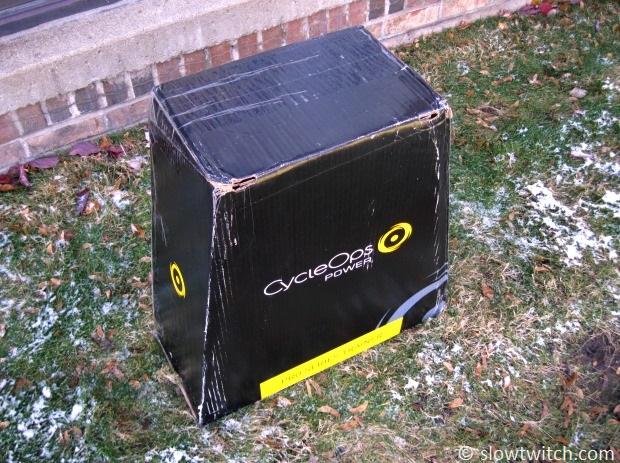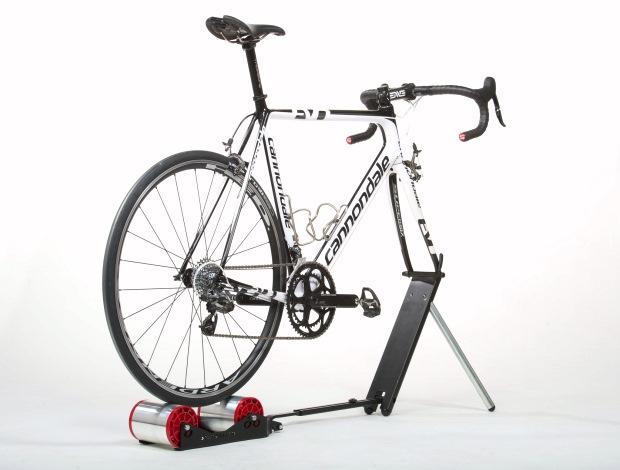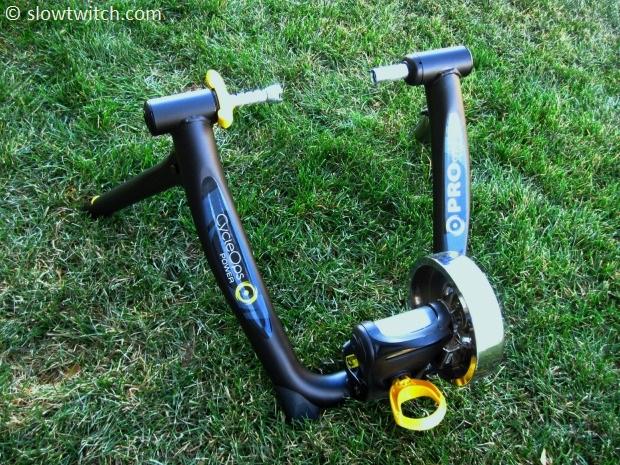Direct Drive Trainers
Call me a luddite, but I’m slow to pick up on some of the latest technology. I like to keep my life simple, and my equipment is a reflection of that. It’s not that I’m against new technology in general – I just reserve judgment until I understand the full picture and whether or not it truly adds value to my life. New technology does, however, light my fire as a learning experience. Although my gear may be simple, I love learning about the newest stuff and helping others learn from my experiences. There are always ins and outs to consider, and ways to maximize your investment.
The latest category of new gear that has piqued my interest is the removable-rear-wheel trainer (say that five times fast). Some call this 'Direct Drive', but I don't know if there is an official industry-wide name yet. These include products such as the well-established LeMond Revolution, the CycleOps Silencer, and the electronic Wahoo KICKR. All feature their own integrated gear cluster (cassette), and require that the rear wheel be removed from the bike. What are the advantages of such trainers? Who is the target customer? What should you consider before buying? Let’s find some answers.
Removable-Rear-Wheel Trainers for Dummies (like me)
At first glance, these aren’t your garden variety indoor trainers. For example, here is the new CycleOps Silencer:
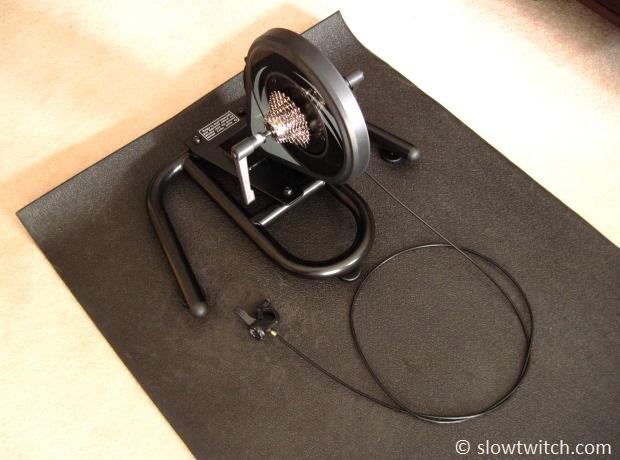
I asked a variety of folks about these trainers – folks that I consider to be very well established triathletes, but not necessarily on the cutting edge of technology. Most of these people have finished at least one Ironman, own more than one bike, and participate with a local training group. Two questions came up consistently:
1) Why is this better than a traditional trainer?
2) How do you attach your bike to it?
The answer to number one is simple: They take tire wear out of the equation. Gone are the days of flat-spotted rear tires that serve double duty as road and trainer tires. Some argue that they also don’t produce as much noise and have a more realistic road feel. To that, I say: ‘Yes and no’. This style of trainer has the potential for both, but it is not a given. I have used traditional trainers that are quieter, and produce a ride feel that is just as good. We’ll touch on these in greater detail later on.
The second question – ‘How do you attach your bike to it’ – varies a little bit by trainer. Obviously the rear wheel must come out of the bike first. Most of the trainers can be sold with their own cassette as part of the deal, such as the Wahoo KICKR:
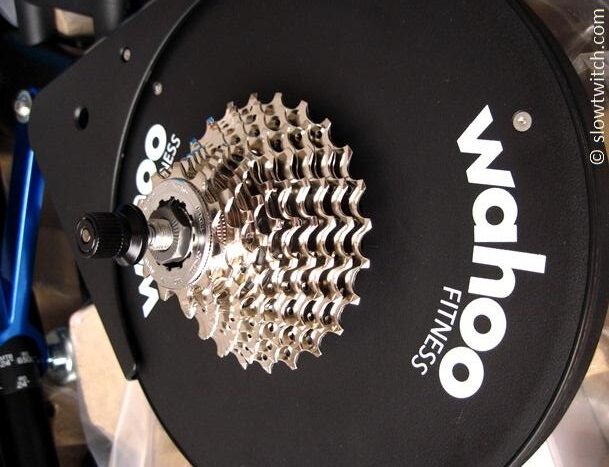
Not all of these trainers include a cassette, so check before buying. When in doubt, I suggest buying a trainer without the cassette, because there are a lot of different possibilities out there. For example, Shimano currently sells 9, 10, and 11-speed systems in 2014. Campagnolo requires their own unique cassette design, regardless of how many speeds there are. All of the removable-rear-wheel trainers that I’m aware of are compatible with 9, 10, and 11-speed cassettes, but only ship with 10-speed.
Whatever the case, you want to have a whole separate cassette on your trainer. You could theoretically swap one cassette back and forth between your bike and the trainer, but it’s more trouble than the average person will want to deal with. If you want to share the trainer with your spouse, you both must have the same type of drivetrain on your bikes. If he has 10-speed and she has 11-speed, you’re out of luck.
Once you have the cassette situation figured out, actually attaching your bike to the trainer is fairly simple. The Wahoo KICKR uses a standard quick release skewer, just like a wheel:
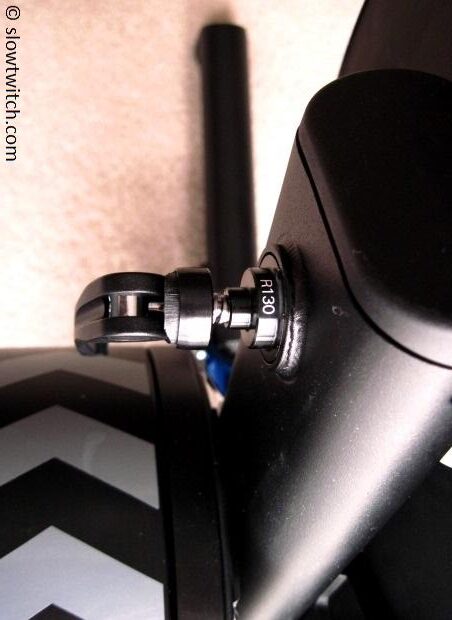
You’ll notice, however, that the CycleOps Silencer uses an externally-threaded axle:
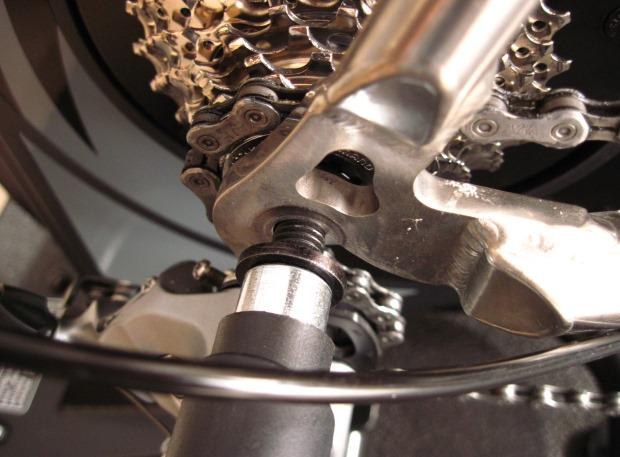
The trainer includes two threaded levers that clamp down on the bike. Note that it also requires four knurled steel washers to ensure a tight grip on the frame – make sure the textured side faces the frame dropouts:
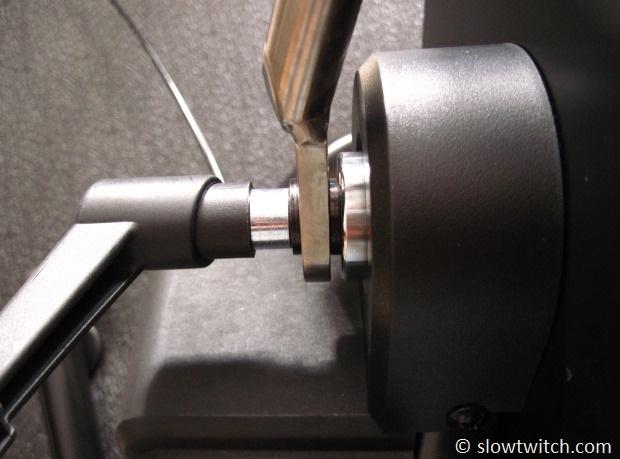
These trainers can be used with a front wheel block (e.g. ‘climbing block’) if desired. My CycleOps Silencer can be used without one, however, if I want the bike to be level with the ground:
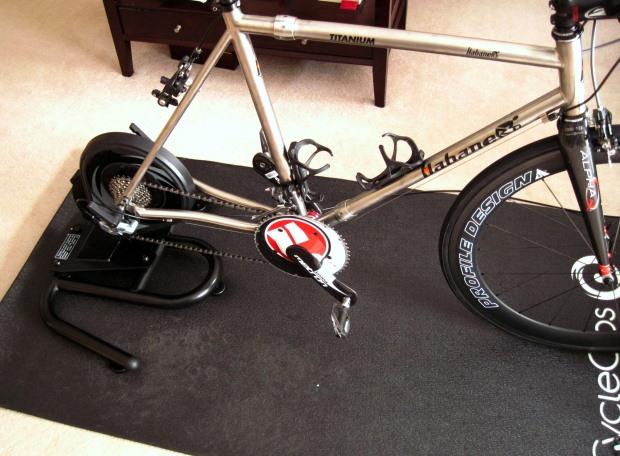
There you have it. That’s the short version of How These Darn Things Work, for those that have zero experience.
—
For those that want more specifics on these trainers, I’m going to discuss the three models that I have experience with – the LeMond Revolution, CycleOps Silencer, and Wahoo KICKR.
LeMond Revolution
The LeMond Revolution has been around for the longest of these three trainers. Unlike the Silencer and KICKR, it has a large integrated fan:
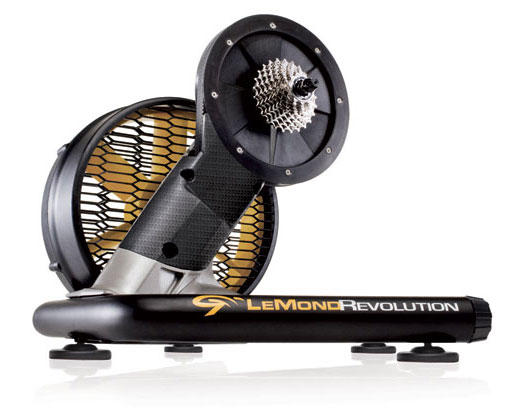
LeMond Revolution specs:
MSRP: $629 (without cassette)
Weight: 32 pounds
Compatibility: 9/10-speed Shimano and SRAM
Optional compatibility: 11-speed Shimano and SRAM, 11-speed Campagnolo
Frame compatibility: 130mm road or 135mm mountain/cyclocross
I have only used the Revolution for two rides, but found that it delivered the advertised realistic road feel. It winds up momentum and keeps spinning for a long time after you stop pedaling.
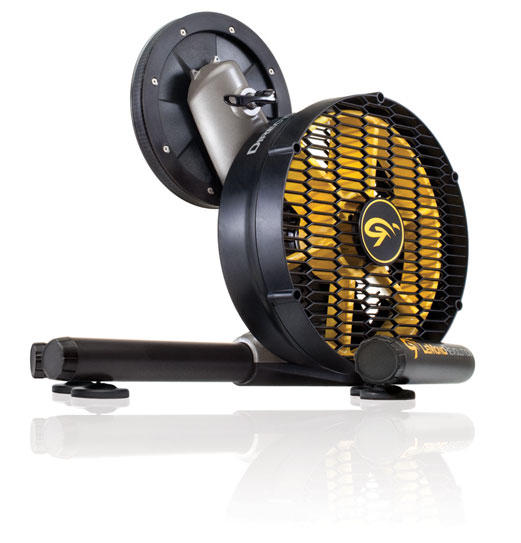
I’ve heard criticism for the Revolution because it’s loud. After riding it, I must agree – it is loud. For riding in the basement or garage – or during the day – this won’t be an issue for most people. If you live in a small apartment, however, and must ride while others are sleeping, the Revolution likely won’t work for you. Call me crazy, but for hard workouts, I actually like the noise. Perhaps it is due to the same reason that men like loud engines on muscle cars. Noise equals power! We’re lame.
This is the best-established trainer of this type, and also comes with the lowest price of our bunch.
CycleOps’ The Silencer Direct Drive Mag Trainer
The CycleOps Silencer is kinda-sorta similar to the aforementioned LeMond Revolution in that it is non-electronic. However, rather than having a big integrated fan, the Silencer uses adjustable magnetic resistance.
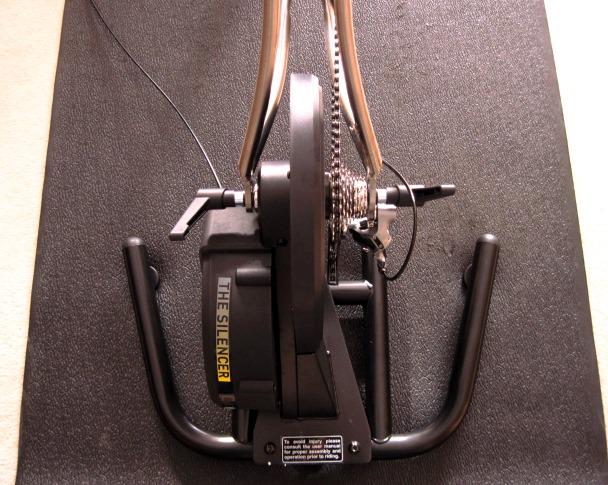
CycleOps Silencer Direct Drive Mag Trainer specs:
MSRP: $659 without cassette, $729 with Shimano Tiagra 10-speed cassette
Weight: 39 pounds
Compatibility: 9/10/11-speed Shimano and SRAM
Frame compatibility: 130mm road or 135mm mountain/cyclocross
Wheel size: 700c, may use 650c with front wheel riser blocks
Unlike the CycleOps Pro Series standard trainers, the Silencer requires some assembly.
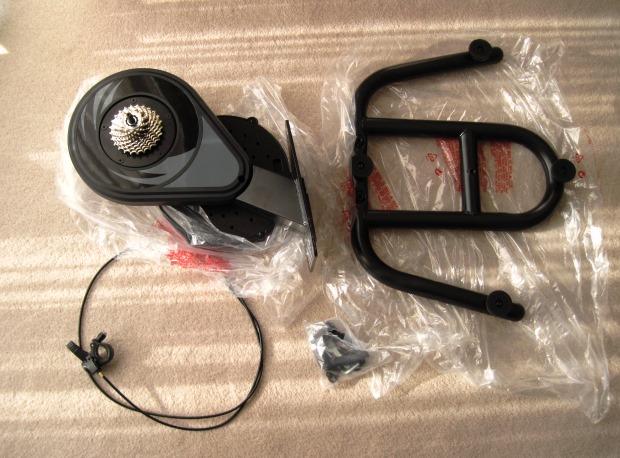
The first thing I noticed about this trainer is it’s heavy. At 39 pounds, it is definitely not something you want to carry around with you. On the flip side, that does make it very stable for riding. The main assembly steps only require that you thread down three large bolts, but you probably want to have a friend help you due to the weight of the system.
If you’ve spent any time around magnetic trainers, you’re probably familiar with handlebar-mounted adjustment knobs. The Silencer has one of these, and it allows you to adjust resistance on-the-fly.
With triathlon bikes, mounting of these resistance knobs can be a little tricky. They’re really intended for road and mountain handlebars, which tend to have more open real-estate for mounting accessories. I was able to mount mine on my base bar, but it did get in the way a little bit:
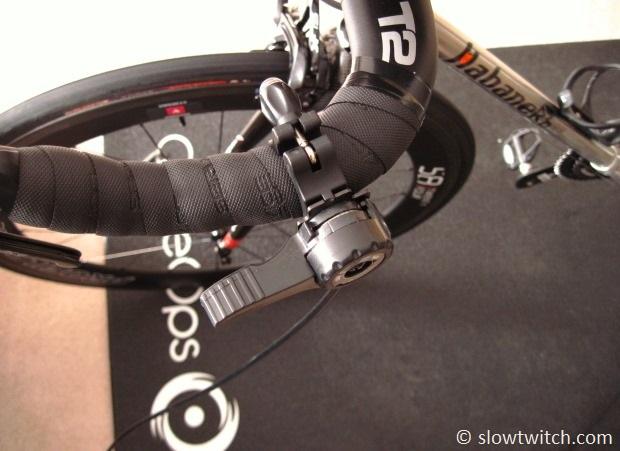
While I don’t have a huge amount of time on the Silencer, I’ve found it to roll smoothly as-advertised. It is rock solid and maintains momentum well. The noise level is definitely on the low end of the spectrum, but not as quite as quiet as the SuperMagneto Pro, which we recently reviewed. Just to be sure, I had my wife ride the SuperMagneto next to me on the Silencer, and her trainer was indeed a touch quieter. Compared to the noise of the LeMond, however, the Silencer is in another world.
Wahoo KICKR
The KICKR is the full-tilt whiz-bang trainer in this category. It competes with electronic trainers such as the RacerMate CompuTrainer and CycleOps PowerBeam Pro.
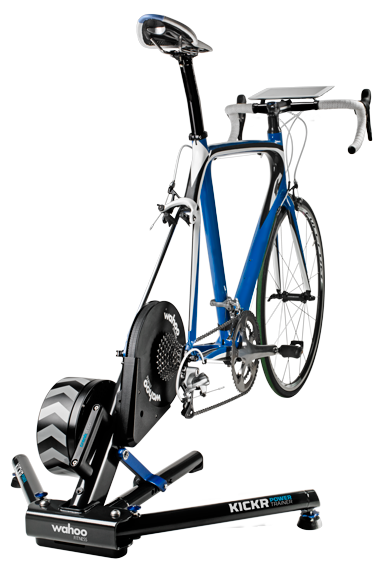
Wahoo KICKR specs:
MSRP: $1,099 (including Shimano Tiagra 10-speed cassette)
Weight: 45 pounds
Compatibility: 9/10/11-speed Shimano and SRAM
Optional compatibility: Campagnolo 11-speed
Frame compatibility: 130mm road or 135mm mountain/cyclocross
Wheel size: 24”, 26”, 650c, 700c, 650b, 29er
While the KICKR looks pricey at first glance, it is actually right in-line with the $1,000 CycleOps Powerbeam, and significantly cheaper than the Computrainer’s $1,630+ price tag.
When my test KICKR first arrived, I noticed that – like the Silencer – it is super heavy. The KICKR clocks in at a full 45 pounds.
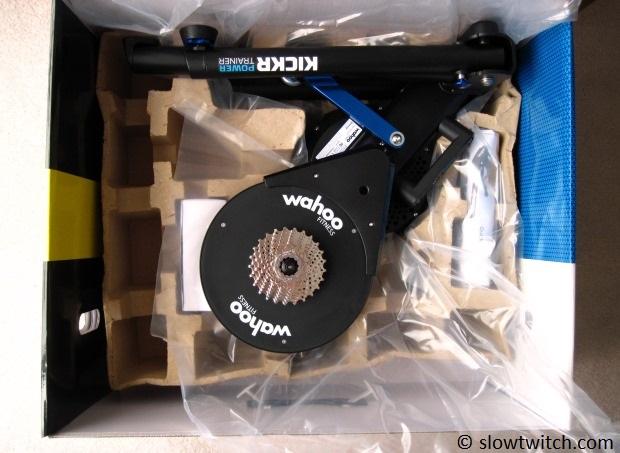
Unlike the Silencer, however, it arrives fully assembled. All you must do is extend the two legs by pushing down on a blue button:
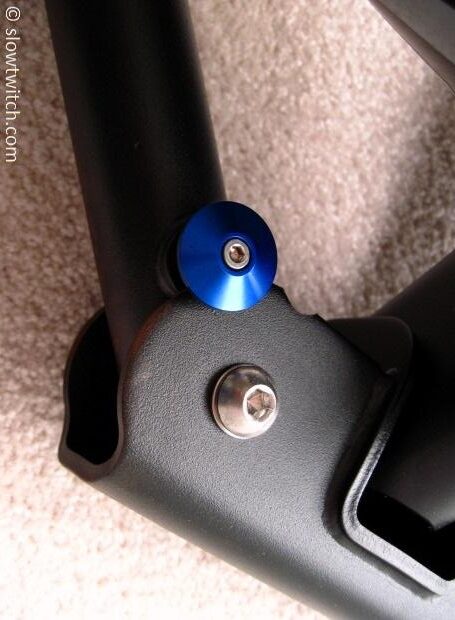
With wheel size compatibility, Wahoo did their homework. Unlike the other trainers that rely on riser blocks, the KICKR has a very easy-to-use adjustment slider for just about any wheel size:
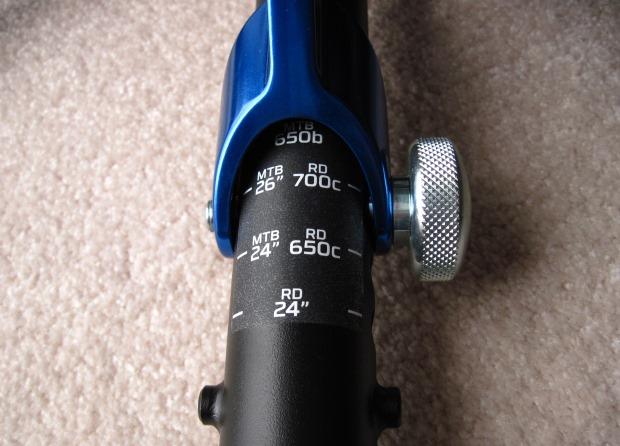
The KICKR may be used with many different devices, seen here:

In terms of software support, there are a lot of options. To many, that is the biggest advantage of the KICKR – it is essentially open-source and has unlimited opportunity for new software. Some of the current apps and programs include Strava, TrainerRoad, VeloReality, Kinomap, PerfPRO Studio, and Wahoo’s own Fitness App, seen here:
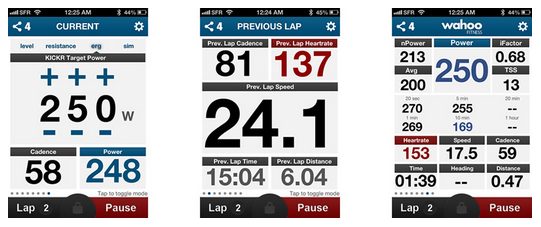
To date, I have only used the KICKR with TrainerRoad, and found the experience to be, well, cool. For the serious indoor cyclist, there are a lot of great features. Finally, I give Wahoo the Homework Award for thinking through all of the details very well – the legs fold, it fits every wheel size, and even has a very convenient carry handle.
Are these trainers for you?
I really lump these three trainers into two categories: Electronic and non-electronic. In the non-electronic group, we have the Silencer and Revolution. If you are concerned with tire wear, I can wholeheartedly recommend either as a great choice. The LeMond is louder and less expensive, while the Silencer is quieter and more expensive.
The other thing to consider is how much space you have at home. If you have enough room to leave your bike on the trainer at all times (e.g. all winter), removable-rear-wheel trainers are great. If, however, you have less space and must set up the bike every time you ride, standard trainers are easier for the masses. Similar to swapping between training wheels and race wheels, cassette spacing isn’t always consistent, so you may have to adjust your rear derailleur when putting your bike on this new style of trainer. I personally do not have enough room to leave a bike on the trainer at all times, so I still give the nod to traditional trainers.
In the electronic category, the KICKR is a very strong new competitor. There are a ton of options with software and devices, but unfortunately no Android phone support at this time. The biggest hurdle with all electronic trainers, in my opinion, is that you’re at the mercy of what your friends have. In my local training group, CompuTrainer is by far the most popular choice. People gather to do group rides, and also ride online with software such as Tour de Giro. If you want to have full features and support with Tour de Giro, you must have a CompuTrainer. If all of your friends have the CycleOps PowerBeam, you’re probably going to buy a PowerBeam. If your Strava pals buy KICKRs… you get it. As much as we’d love for all these different devices to ‘play nice’ together, it is undoubtedly costly to write software that supports everything.



